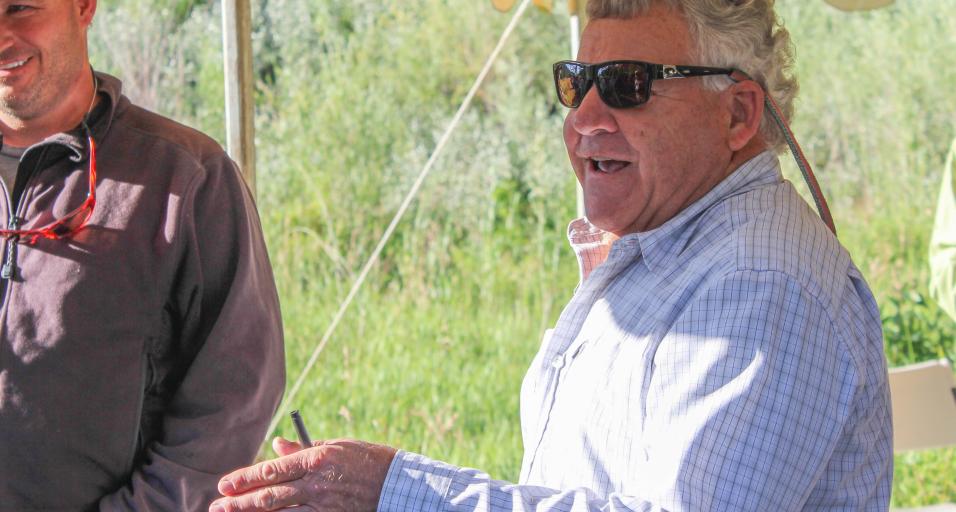Mark Fowden, the Wyoming Game and Fish Department’s chief of fisheries is retiring after 39 years with Game and Fish, five of those as chief. Fowden’s leadership is described as visionary and inspirational for Wyoming with long-term impacts on the health and prosperity of the state’s the fisheries.
Following several long term seasonal contracts, Fowden began his Game and Fish career in Casper with the Reservoir Research and Fish Population Crew in 1979. Fowden’s time was spent collecting fisheries trend and population data for all large lakes and reservoirs in the the state. In 1982 he transferred to Laramie as a fish population biologist developing methods and equipment to improve electrofishing techniques for use on larger streams throughout the state. In 1987 he was promoted to the regional fisheries supervisor in the Green River Region where he worked for nine years. Where he developed a penchant for restoring watershed and improving stream fishery habitats.
In 1996, Fowden was again promoted, this time to aquatic habitat supervisor. In this role, Fowden restructured the unit to place an aquatic habitat biologist in each region and focus on watershed function and health.
“He always maintained a broad vision, whether he was standing in a stream looking at the top of the mountain or standing on top of the mountain looking down into the stream he understood all of the aspects of habitat management and how it was all tied together,” said Game and Fish Director Scott Talbott.
Fowden became the assistant chief of fisheries in 2001, where he worked on-what his colleagues describe as a legacy project. Due to the work of Fowden, and retired chief, Mike Stone, in March 2010, the Wyoming Aquatic Invasive Species Act was passed by the state legislature and signed into law by the Governor. Subsequent to this Act, the Wyoming Game and Fish Commission passed both an emergency and final regulation relating to aquatic invasive species (AIS). The program is one of only five Game and Fish programs to be partially supported by the State of Wyoming’s General Fund.
“Mark’s vision and leadership on the AIS program built a foundation to make this initiative strong, and his urging to prioritizing invasive species projects has brought together many western states to ensure policy and program strategy consistency,” said Dirk Miller, Game and Fish assistant chief of fisheries.
Fowden began serving as chief of fisheries in 2012, continuing to invest in projects with long-lasting benefits to Wyoming. In 2014, Game and Fish signed a lease agreement with Johnson County for water rights in Lake DeSmet to guarantee adequate water in the lake for 99 years for fishing, boating and recreation. The project brokered partnerships between Game and Fish, Johnson County, the Wyoming Water Development Commission and the public.
“Mark is one of those rare individuals who has the ability to mix the social science with the biological science. He truly understands that in order to implement management recommendations for wildlife, the public must understand and support the proposals as well. He is well respected by his colleagues in Wyoming, across the region and across the nation and with professionals as well as the public,” said Talbott.
Fowden’s last day with Game and Fish is Jan. 3, 2017 and has plans to literally sail into the sunset, pursuing his lifelong dreams to sail the Caribbean waters as well spend time in Cheyenne and Jackson with family and friends.
“After all my years at Game and Fish, I can say I could do this for another 4 or 5 years; I still can’t resist getting out into the field with our people and others that cherish fish and aquatic habitat. “Truly it’s been my honor to serve the people and their fisheries and wildlife resources of Wyoming for 39 years.”
Fowden earned a bachelor’s degree in biology and a master’s in fisheries management from the University of Wyoming. In 1989, he was named the Game and Fish’s “Fish Division Employee of the Year,” and received the “Director’s Award” in 1993 and the “Award of Excellence” from the Colorado-Wyoming Chapter of the American Fisheries Society in 2002.
Mark Fowden, Game and Fish chief of fisheries retires after 39 years
Wyoming Game and Fish (307) 777-4600


